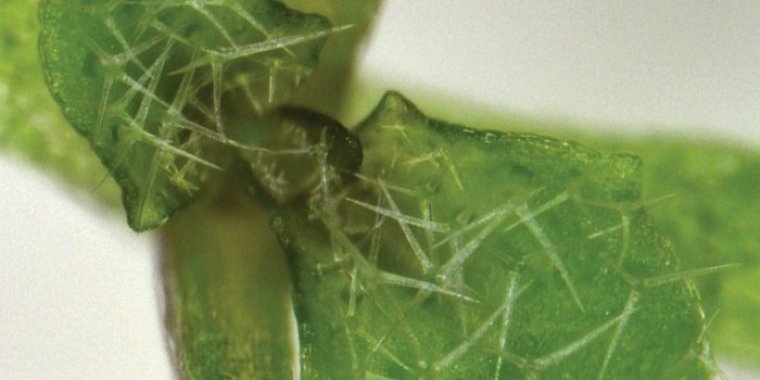| News / Science News |
Plants: RNA notes to self
How does a developing plant shoot know how, where and when to grow? Dividing cells need to pass messages from one another to coordinate growth. In plants, important messages are packaged into RNA, which are sent from cell to cell.

This Arabidopsis thaliana plant, a relative of mustard, is developing properly. Photo: Munenori Kitagawa/Jackson lab/CSHL
By studying the mustard-like plant Arabidopsis thaliana, Cold Spring Harbor Laboratory scientist David Jackson and colleagues found that RNA messages need a special protein to escort them where they need to go. Without this escort, cells cannot coordinate and the plant fails to develop properly.
Unlike animal cells, plant cells are surrounded by a rigid cell wall. Messages can cross this wall through tiny holes called plasmodesmata.
Munenori Kitagawa, who led a study published in the journal Science, says that "plasmodesmata are nanochannels embedded in the cell wall. They mediate various signals' transport from cell to cell, including protein, RNA, hormones, ions and nutrients."
The researchers wondered how plasmodesmata's gates regulate messaging from one cell to the next. They discovered that RNA signaling relied on a protein called AtRRP44a.
Lowering the amount of AtRRP44a slowed the movement of RNA messages; lacking the right messages, the plants failed to develop properly.
A protein like this escort protein is present in other plants, yeast and animals. The researchers were able to swap out part of the Arabidopsis thaliana signaling system with parts from corn and restore normal development, showing that the signaling system is similar in many kinds of plants.
Jackson says that "plants are very sophisticated. We think of them just sitting in their environment, not moving, but they're processing a lot of information. The different parts of plants are talking to each other, sharing whether they have a pathogen attack or if they need some nutrients."
In a related study, Jackson and collaborators found that signals transported through these gates can increase the number of cell layers in corn roots, making the plants potentially more resilient to environmental change. (National Science Foundation)
YOU MAY ALSO LIKE





